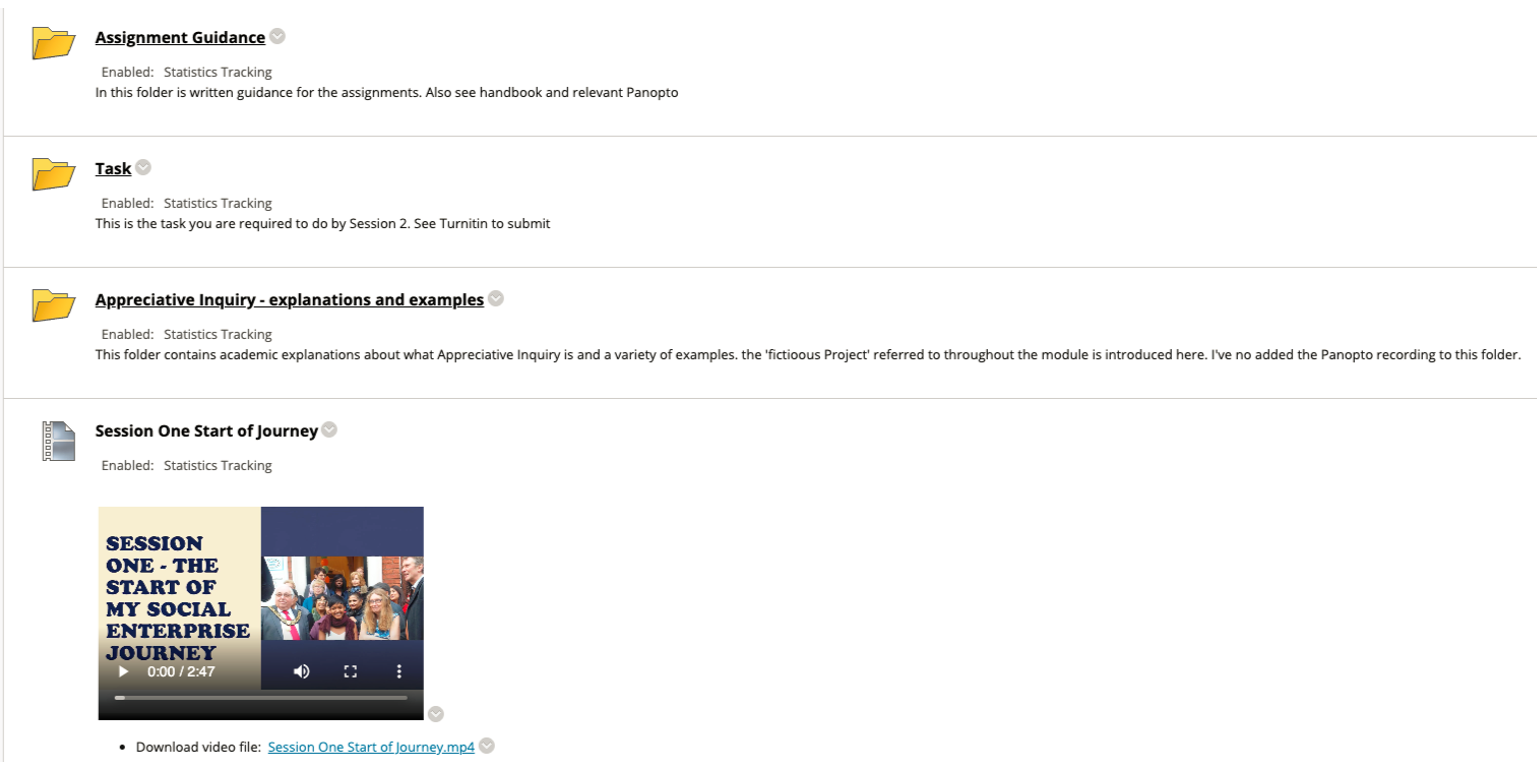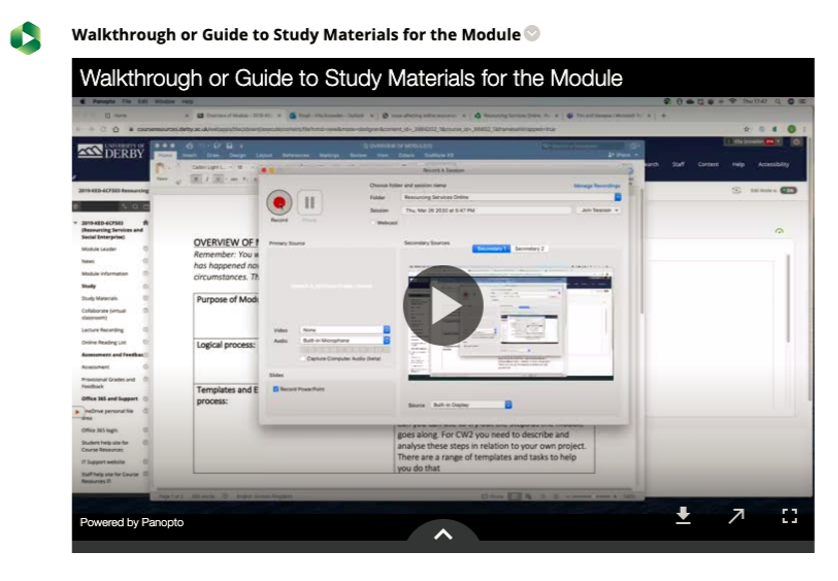
Vita Snowden, a Lecturer in the Department of Social and Community Studies, talks about her experiences of adapting her module for remote teaching. Vita is Module Leader for the module Resourcing Services as part of the BSc Child and Family Health and Wellbeing programme. This module, normally taught across two campuses (Derby and Chesterfield) has around 35 students taking this at level six. The module covers a range of theories and models about Social Enterprises and not-for-profit organisations and the role they play in meeting the needs of families.
What type of activities have you been running with your students?
I have used an eclectic set of activities for my students to cater for a variety of learning styles. I mainly use two platforms for distinctly different purposes:
- Teams for interaction
- Blackboard/Study Materials for study; the ‘manual’ of the Module.
Within that division, I have implemented the following:
Interaction:
- FAQ channels about tasks and assessments
- ”Live’ Q&A sessions
- Generic forum for the students to post anything they like
- Use of chat box by text or phone for individual questions or tutorials
The latter is important because the Module involves each student designing and developing their own project, so they need a higher level of one-to-one support than if this wasn’t the case.
In addition, I have asked them to submit tasks (which I’d originally intended to be carried out in the classroom) to Turnitin and I give them feedback which directly relates to how the individual student can build on the formative work towards their course work.
Study Materials:
I have turned Study Materials into a kind of detailed ‘manual’ for the Module with descriptions about each session’s content. The ‘manual’ includes a video and word document ‘walkthrough’ of the module – its purpose and where to find what.
The same documentation is included in different folders in several places (e.g. in addition to the number of dated weekly sessions, there are other key folders such as an assessment folder and a ‘task’ folder). I recognised early on that, intuitively, we would all look for information in different places within a large ‘manual’ and attempted to cater for that.
I have uploaded shortish Panopto’s on particular topics but have always provided PowerPoint separately without audio as an alternative.

Do you have any tips for others who might want to try this out?
I had already prepared this module for face-to-face teaching and had to turn it round very quickly as my first session was the same week as Lockdown started. My starting point, therefore, was: ‘What different information and activities do students need online that is not quite such a priority face-to-face?’. I quickly concluded that the root of the difference was that everything needed to be planned out in detail and communicated in easy-to-follow ways which is when I started to reconstruct Study Materials.
In addition, I realised that our students would need to work through the Module at their own pace (the nature of the programme means that the majority of students have children at home during Lockdown). This means that I needed to upload material for the whole Module to allow them to do that. I normally only upload content on a weekly basis to allow me time to reshape it based on individual learning needs of specific classes.

Within this Lockdown and online context, the best tip I could give is to be ready to be flexible and provide as many alternative learning activities and resources as possible for students whilst, simultaneously, creating simple step-by-step guides. It is easy to get lost when there is lots of online information. This is particularly true right now when many of the students are struggling practically and emotionally (as most of us are in our different ways) and seek consistency and reliability in their world of study.

Why do you think students have found these activities engaging?
The feedback I have received so far has been that students have appreciated the level of planning and organisation that has gone into the module and the ‘efforts’ I am making. When students question why they should undertake, for example, a task, I provide a clear rationale (in effect the same information in different ways) in the interactive space (Teams) and I also use that space to negotiate flexibility where that is possible. During the mid-evaluation stage, students confirmed that the approach of providing simple, easy-to-follow guidance to the materials was the right one. They asked for even more of this as it relates to the assessments and I supplied the same information in yet another format. One source of anxiety is not being able to access the original reading list because the library is closed. I have not supplied an alternative reading list but I have provided another guide (to online library searches of relevance to the module). What the students most appreciate is a responsive and flexible approach.

How have you built in flexibility to account for the students who are studying at different times?
My answers above address this question so the question is inbuilt into my model: By providing all the materials for the whole Module in what I hope are clear and alternative ways from the outset. As stated, when teaching face-to-face this isn’t what I would do because I find myself re-shaping my next planned session based on feedback and a better understanding of the learning needs of individual classes.
All live sessions are recorded. I have offered evening individual and small group sessions and some students with young children have stated that this would be better for them. The individual chat/telephone tutorial can happen at a time to suit both parties and so is more flexible than it would have been previously face-to-face. I am a part-time lecturer and only attend University on set days of the week.
Final Thoughts

When I started this uncertain journey, I had thought that, once my materials and key messages were constructed, in preparation for remote teaching, that would be the end. For face-to-face teaching, I find myself in a constant weekly shaping and reshaping loop based on changing and emerging student needs. I thought this would be the main difference between remote and face-to-face teaching. In fact, even online, I have continued to reshape my teaching and resources as a result of receiving ongoing feedback from my students. I am not enjoying the stresses and pressures that Lockdown brings to our students and my colleagues. However, I am enjoying the challenges and adventures that remote teaching brings. I invite my colleagues to view remote teaching in this way: we’re all embarking on an unknown adventure – who knows what buried treasures we will find?
How this links to the university expectations
This case study provides a good example of how Blackboard (Course Resources) should be used as a definitive source of module information. Viewing this as a manual helps to guide students through their learning and provides a singular reference point for key guidance.
Although it may not be possible for all modules to replicate Vita’s example, partly due to the context in which the module is being delivered, it is essential that everyone adheres to the minimum remote learning requirements during this period.

- Use Announcements in Blackboard to inform students of the adaptions you are making and ensure the module information is updated accordingly.
- Record all lectures via Panopto, notifying students when new material is available.
- Host Webinars where students can participate remotely. These can be used for tutorials or office hours. Students will need to be informed of expectations on participation.
- Setup a Discussion board, Padlet notice board (linked in Blackboard) or use an existing MS Teams site to facilitate student and staff interactions.